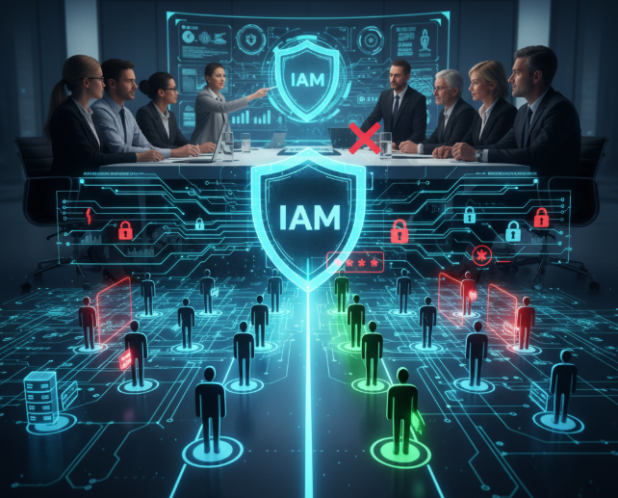Introduction: Why IAM Is Now a Board-Level Priority
IT leaders today face a familiar challenge: security risks keep rising while access sprawl grows across cloud apps, hybrid networks, and remote teams. Passwords alone no longer protect the enterprise—and manual provisioning simply doesn’t scale.
This is where Identity and Access Management (IAM) becomes foundational. IAM basics help organizations control who can access what, verify identities, and enforce the principle of least privilege across every system.
As enterprises modernize, partner ecosystems expand, and employees work from anywhere, IAM becomes essential—not optional.

What Is Identity and Access Management?
Identity and Access Management (IAM) refers to the frameworks, policies, and technologies that ensure the right users have the right level of access to the right resources at the right time.
IAM spans:
- Identity Management: Creating, storing, and managing digital identities.
- Authentication: Verifying users with credentials or biometrics.
- Authorization: Defining what resources a user can access.
- Access Control Systems: Enforcing policies across apps, networks, and devices.
Why IAM Matters More Than Ever
A modern IAM program strengthens both security and operations:
1. Reduced Cybersecurity Risk
Stolen credentials remain one of the most common attack vectors. IAM tools enforce MFA, zero-trust principles, and continuous monitoring.
2. Operational Efficiency
Automated provisioning and role-based access eliminate manual admin tasks and onboarding delays.
3. Compliance Simplification
IAM supports audit trails, least privilege access, and identity governance required by SOC 2, HIPAA, and ISO.
4. Scalability for Hybrid and Remote Workforces
As organizations adopt more SaaS tools, IAM ensures consistent policy enforcement across all environments.
Core Components of IAM (Simple Framework)
1. Identity Lifecycle Management
- User creation
- Role assignment
- Access request workflows
- Automated user deprovisioning
2. Authentication (Prove Who You Are)
- MFA
- Biometrics
- SSO
- Passwordless methods (WebAuthn, device trust)
3. Authorization (Control What You Can Do)
- Role-based access control (RBAC)
- Attribute-based access control (ABAC)
- Policy enforcement
4. Access Governance
- Access reviews
- Privileged access management
- Compliance reporting
Cisco vs Aruba? AI vs Traditional Security? IAM Sits at the Center
As companies modernize their networks, migrate workloads to cloud, or adopt AI-driven security tools, IAM becomes the glue that connects every layer of the stack.
OmniLegion often supports clients by:
- Integrating IAM with endpoint and network access control
- Selecting the right IAM vendor for scale
- Training IT teams and sourcing IAM engineers
- Designing governance frameworks that reduce breach exposure
For teams needing hands-on support, explore OmniLegion’s enterprise IT support services (https://omnilegion.com/get-it-help/) or review real-world case studies (https://omnilegion.com/case-studies) to see how IAM upgrades transform operations.
IAM Comparison Table (At a Glance)
| Component | What It Does | Why It Matters |
|---|---|---|
| Authentication | Verifies identity | Blocks unauthorized users |
| Authorization | Defines access rights | Prevents privilege creep |
| Identity Governance | Ensures compliance | Supports audits & reporting |
| Provisioning | Manages user lifecycle | Speeds up onboarding/offboarding |
FAQs About Identity and Access Management
1. What is the difference between identity management and access management?
Identity management handles who a user is; access management controls what they’re allowed to do.
2. Why is IAM important for cybersecurity?
Compromised identities cause the majority of breaches. IAM helps enforce MFA, least privilege access, and policy‑driven controls.
3. What tools are commonly used for IAM?
Azure AD, Okta, Ping Identity, CyberArk, and similar tools handle identity, authentication, and governance.
4. How can IAM support zero trust?
IAM verifies identities continuously, enforces least privilege, and integrates with network and endpoint controls—core pillars of Zero Trust Architecture.
5. How do I know if my organization needs IAM modernization?
Signs include access sprawl, slow onboarding, shadow IT, audit failures, and inconsistent MFA across apps.
Soft CTA: Need Guidance Modernizing IAM?
IAM is the foundation of enterprise security—and getting it right requires strategic alignment across people, processes, and technology. OmniLegion helps organizations evaluate IAM tools, source skilled identity engineers, and design scalable access frameworks.
If you need support, explore IT assistance (https://omnilegion.com/get-it-help/) or contact our team (https://omnilegion.com/contact-us/) for guidance.

